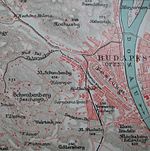Three Border Mountain
Hungary geography stubsMountains of HungaryÓbuda

Three Border Mountain (Hungarian: Hármashatár-hegy, German: Drei·hotter·berg) is the name of a mountain in the city of Budapest, Hungary. Its name comes from the fact that the borders of three cities (Buda, Óbuda, Pesthidegkút) met at this point in the 19th century. Today, these cities have merged into Budapest, but the mountain's name has remained unchanged. The border between the 2nd district and 3rd district still bisects the mountain.
Excerpt from the Wikipedia article Three Border Mountain (License: CC BY-SA 3.0, Authors, Images).Three Border Mountain
vitorlázó start-rámpa, Budapest Kővár
Geographical coordinates (GPS) Address Nearby Places Show on map
Geographical coordinates (GPS)
| Latitude | Longitude |
|---|---|
| N 47.5553 ° | E 18.9991 ° |
Address
vitorlázó start-rámpa
1028 Budapest, Kővár
Hungary
Open on Google Maps








